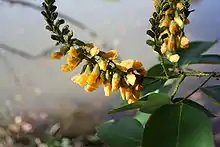Pterocarpus santalinoides
Pterocarpus santalinoides is a tree species in the legume family (biology) (Fabaceae); it is locally known as mututi.[2]
| Pterocarpus santalinoides | |
|---|---|
 | |
| Pterocarpus santalinoides inflorescences, Comoé-Léraba reserve, Burkina Faso | |
| Scientific classification | |
| Kingdom: | |
| (unranked): | |
| (unranked): | |
| (unranked): | |
| Order: | |
| Family: | |
| Subfamily: | |
| Tribe: | |
| Genus: | |
| Species: | P. santalinoides |
| Binomial name | |
| Pterocarpus santalinoides | |
| Synonyms | |
|
[2] | |
It has a remarkable bi-continental distribution, native to tropical western Africa (Benin, Burkina Faso, Cameroon, Gambia, Ghana, Guinea, Guinea-Bissau, Ivory Coast, Liberia, Mali, Nigeria, Senegal, Sierra Leone, Togo) and also to South America (Brazil, Colombia, French Guiana, Guyana, Paraguay, Peru, Suriname, Trinidad and Tobago, and Venezuela).[3]
It grows to 9–12 m tall, with a trunk up to 1 m in diameter and flaky bark. The leaves are pinnate, 10–20 cm long, with 5–9 leaflets. The flowers are orange-yellow, produced in panicles. The fruit is a pod 3.5–6 cm long, with a wing extending three-quarters around the margin.[4]
Footnotes
- "Pterocarpus santalinoides". Actos Database. Retrieved 9 April 2018.
- ILDIS (2005)
- Prado (1998), ILDIS (2005)
- World Agroforestry Centre: Pterocarpus santalinoides
References
- International Legume Database & Information Service (ILDIS) (2005): Pterocarpus santalinoides. Version 10.01, November 2005. Retrieved 2008-NOV-01.
- Prado, D. (1998). "Pterocarpus santalinoides". IUCN Red List of Threatened Species. 1998: e.T33471A9786333. doi:10.2305/IUCN.UK.1998.RLTS.T33471A9786333.en.
- World Agroforestry Centre (WAC) [2008]: AgroForestryTree Database – Pterocarpus santalinoides. Retrieved 2008-NOV-01.
